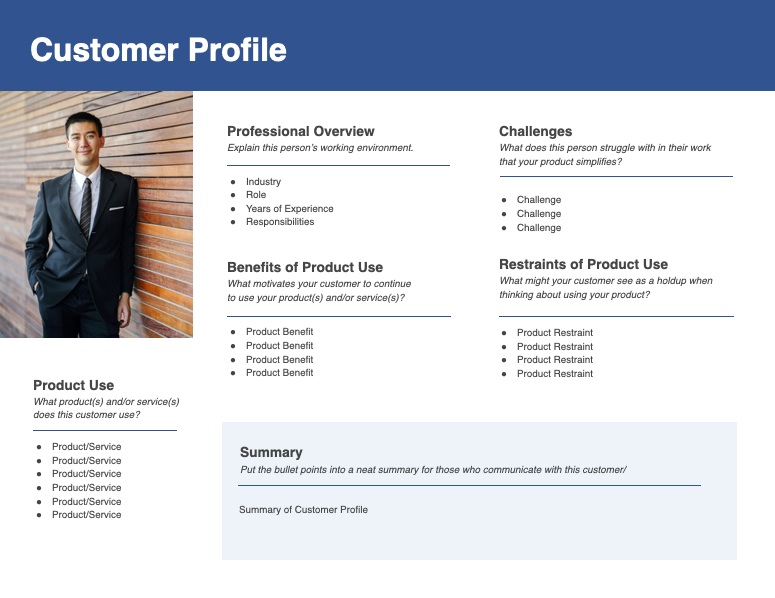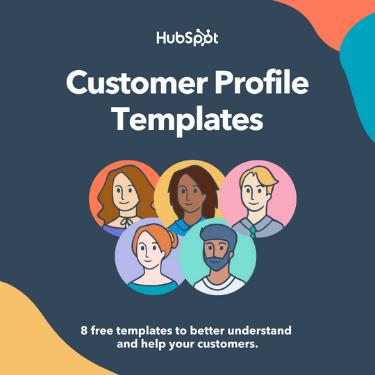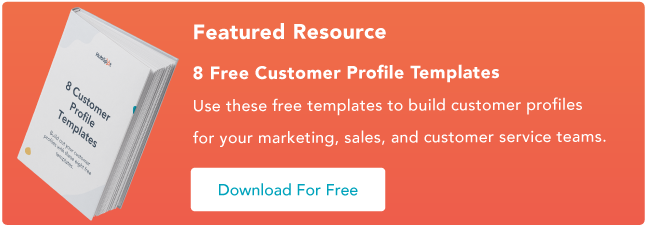Customer profiling is an essential aspect of serving customers. But what is customer profiling?

As a small business owner, I’ve found that understanding customers' specific demographics, tendencies, and pain points is indispensable in meeting their needs. To market and sell to customers effectively, I believe you must put yourself in the customer’s shoes, and customer profiling helps you do that.
What exactly is the definition of customer profiling, you ask? I’ve got you. Read on for a full breakdown of customer profiling, what it is, why it’s essential, and a 10-step guide to creating your customer profiles.
Continue reading or jump ahead:
- What is a customer profile?
- Why is customer profiling important?
- Customer Profiling Benefits
- Customer Profile Data
- How to Create a Customer Profile (10 Easy Steps)
- Customer Profile Templates
- Customer Profile Examples
Customer Profile
A customer profile is a data-driven document that describes your current customers. Profiles are based on surveys that gather purchasing behaviors, pain points, psychographic data, and demographics. A customer profile can help you find segments of customers with commonality so you can target them in your sales and marketing campaigns.
If you don't create customer profiles, you risk marketing to a nondescript audience, wasting time, and losing deals. Take it from me, someone who learned that lesson the hard way.
Defining your ideal customer entails gathering and analyzing data about your customers' characteristics, behaviors, attributes, and needs. This information is used to create profiles representing your customer segments.
Sounds great, right? But what is customer profiling exactly? Let's take a look at a sample below.
Customer Profile Sample
Download the Free Customer Profile Templates
Creating a customer profile can be simple. You can create a customer profile just like this one using our free customer profile templates.
With our templates, you don't have to start from scratch. Just fill in the blanks and use the data from your service software or surveys to create a complete consumer profile.
I’ve found these customer profile templates to be a valuable, time-saving tool when creating customer profiles for my business. In my experience, it’s always been beneficial to take advantage of time-saving resources like this that allow me to focus more energy on delighting customers.
Before creating a customer profile, consider your target audience.
If your company is in the B2B space, you'll need to include more detailed information about your customers, such as industry size, regional location, etc.
If you‘re in the B2C space, you’ll want to create a customer profile focused on the individual.
Let's take a quick look at each element of the above template.
Products/Services Used
This section of the customer profile template describes which of your services your customers rely on and how they use them. You can also include other products or services customers use with your service.
If your product can be integrated with another service and customers are successfully meshing your service with another, add that to this section. This will help you better market to other companies or individuals later.
Demographics
Your customers‘ demographics are an essential piece of your customer profile. When writing this section, include your customer’s career, industry, location, and gender identity.
Sure, only some customers will fit your demographic mold, but having a general idea of basic customer information is extremely helpful for your company's bottom line.
I run a music backline rental company, and my customers range from High Schools to Weddings to Touring Bands. These different types of customers have various attributes, and I’ve found that outlining the demographics of each customer segment helps me better anticipate their needs.
Customer Benefits
Your customer profile should also include a list of benefits customers receive by using your product or service. How does your product or service provide value to your customers?
Think about how your product or service adds value for your customers and describe it in this section. The best way to answer this question is to ask your customer base. Compile and compare their answers and add a summary here.
Getting customer feedback requires convincing. I’ve personally discovered that offering an incentive such as a small discount or upgrade is a great way to encourage customers to deliver the feedback that is so valuable to your customer profiles.
Customer Pain Points
While surveying customers, I like to ask about their pain points, which, ideally, I can solve.
Be sure to list pain points that you can actually solve for your customers. You'll want to focus on these pain points in your customer profile.

8 Free Customer Profile Templates
Use these free templates to build out your customer profiles for your marketing, sales, and customer service teams.
- Long Customer Profile Templates
- Short Customer Profile Templates
- Designed Customer Profile Templates
- Simple Customer Profile Templates
Download Free
All fields are required.

Finding the Ideal Customer Profile For Your Business
When I realized I could use my already existing customers as a model for my customer profiles, it was like a lightbulb going off over my head.
Rather than coming up with ideal, imaginary attributes for buyer personas, I found it much more straightforward and more realistic to analyze the characteristics of the customers I already work with and segment that data to uncover the customer profiles that were there all along.
While a buyer persona provides a fictionalized individual who represents your customers, a customer profile is rooted in the data and factual information of your customer base.
Everything you need to know about a group of customers is captured within this one description. For this reason, a customer profile comes first, and then you build a buyer persona from it.
Once you've defined these qualities of your target audience, you can segment your customer base into different customer profiles.
Customer Profiling
Customer profiling is the act of describing a customer or set of customers using demographics, psychographics, buying patterns, and other factors. In other words, it's identifying the characteristics of the people most likely to purchase your product or service and derive a lot of value from it.
Why is customer profiling important?
When building a business, developing a go-to-market strategy, or giving your sales team direction, clearly describing your current customers is essential.
I’ve found that the customers most likely to purchase from me in the future are often quite similar to customers who I’ve worked with in the past. Coincidence? I think not.
Customer profiling helps you identify buyers likely to purchase from you, which is more valuable than targeting everyone everywhere. My experience has taught me that taking an informed, targeted approach to customer acquisition is far more effective than casting a wide net.
Trying to build something that solves 100% of the problems for 100% of the market is called “boiling the ocean.” You're “boiling the ocean” when your customer profile is too broad.
The irony is that targeting a broad audience solves only a few problems for only a few people. You end up spreading your product offering too thin and diluting your value across too many customers.
Customer profiles act like guard rails for product managers as they develop a new product, marketers as they craft positioning strategies, and salespeople as they search for potential customers.
Customer profiling is incredibly beneficial for all teams and your business members — let's look at the benefits in more detail below.
Customer Profiling Benefits
Creating customer profiles is crucial for taking your business to the next level. 66% of customers expect companies to understand their needs; customer profiling helps you do that.
A properly executed customer profiling strategy has far-reaching benefits across your entire organization. Read on to discover the many benefits of customer profiling.

It helps all departments become more efficient.
The benefits of customer profiling are impactful across your entire company. Each department in your company will use your customer profiles differently, but they will improve the bottom line.
- Marketing: Understanding the client is vital to creating engaging advertisements or emails for potential prospects and current clients. Marketers use customer profiles to customize messaging to most effectively speak to customer needs.
- Sales: With a customer profile in hand, your sales team will be able to highlight customer pain points and help better sell your product or service as the solution to their problems. Your sales team may even use the customer profile to find ways to create connections with current and future clients.
- Support: The customer profile contains all the necessary information your customer service team will need to assist clients in need. It can act as a record of queries, complaints, and previously tried solutions. This will help save time for your customer service team and keep everyone involved from becoming frustrated.
It allows you to identify better-fit prospects.
By knowing who benefits from your products the most, your organization can find better prospects and increase close rates.
If you're part of the service team, this might not mean much to you. But remember: A better-fit prospect is a happier customer down the line.
It lowers customer acquisition cost.
Customer acquisition cost (CAC) is the money you spend on marketing and sales campaigns to attract a single customer. Implementing customer profiling allows you to focus your efforts on people who are more likely to become customers, which brings customer acquisition costs down in the long run.
I’ve personally discovered this to be true when running social media ads for my business. A well-defined customer profile meant I could target the right people online and lower my ad spend.
It empowers you to serve customers better.
Knowing your customers is critical to serving them better. I found this accurate, having worked on the Support Team at HubSpot at the beginning of my career. We always kept detailed notes on each customer, including the issues they had in the past and their needs/goals. Armed with this information, I was much better equipped to meet customers where they were and guide them to success.
By documenting customer pain points, attributes, and characteristics, you can deliver a superior customer service experience before they ever request help.
You can predict issues before they arise, provide practical self-help resources, and better align with their needs if they reach out to your service team.
It reduces customer churn.
Customer churn refers to losing customers. We can all agree we want to keep that number as low as possible!
By creating strong customer profiles from the start, you can attract and serve customers who actually want to use your product or service — reducing customer churn in both the short and long term.
Now that you know the benefits of customer profiling, which data should you gather for your customer profiles?
Let's take a look.
Customer Profile Data
A refined customer profile can help you find and attract more people likely to buy your product, develop a stronger relationship with your customers, build more impactful features, and put you on a better trajectory for market dominance.
It’s clear that customer profiling is valuable and effective, but how do you start? It’s easy to feel overwhelmed with so much customer data at your fingertips, but fret not; I’ve got you covered.
Below are the four different types of customer profile data you should be gathering:
Demographic
Demographic data are the concrete characteristics of a customer and can be used to understand consumer behavior, albeit broadly.
Demographics include the following traits (and more):
- Age.
- Sex.
- Job title.
- Income.
- Education level.
- Family status.
If you're in the B2B space, consider attributes such as company size, industry, and other organizational characteristics.
For example, my music backline rental business is technically B2B, and my customer demographics are segmented by Events such as Weddings/Bar Mitzvahs/Graduations, Music Festivals, and Touring Artists who can’t travel or fly with all their gear. Each type of customer has different needs, and understanding customer segments helps me anticipate and meet them.
Psychographic
Demographics alone aren‘t enough to understand how, when, and why people make purchasing decisions, and that’s where psychographics come in.
These factors relate to the attitudes and psychological makeup of a customer and may include:
- Lifestyle.
- Goals.
- Pains.
- Habits.
- Values.
- Interests.
Psychographics help you understand the buying journey and even the customer journey after they've already purchased from you. Psychographic segmentation in email marketing can raise open rates by up to 30% and increase conversion rates by an average of 25%
Behavioral
While psychographics relate to psychological attributes, behavioral segments look at how that's manifested in action.
You may consider segmenting by:
- Engagement.
- Readiness to buy.
- Purchasing history.
- Product usage.
- Satisfaction.
- Loyalty or account age.
- Attention required.
Segments based on behavioral traits are some of the most valuable in customer support. It can help service teams find insights about customer interaction and how these trends manifest into recurring revenue and satisfaction rates.
And once those things are measured, they can be improved.
Geographic
Geographical factors are relevant when location affects how customers interact with a brand or receive their products.
Here are popular ways to segment based on geography:
- City.
- Area.
- Region.
- Country.
Gaining insights based on geography can help your organization think through logistics, support implementation, and marketing.
The relevance of Geographical data varies depending on the type of business you run. In my experience running a music backline rental company, geographic data is hugely relevant because I can only serve customers within a certain radius of where my gear is located.
However, if you run a software business or sell products online, geographical data has a different level of relevance. Regardless, knowing where your customers are is helpful in understanding more about them and their needs.
Once you have this data, you can profile customers based on specific types or “segments.”
Segments help you unearth trends in satisfaction, churn, and lifetime value that help you understand more about your ideal customer profiles.
How to Create a Customer Profile
- Use customer profile templates.
- Choose your customer profiling software.
- Dig into demographics.
- Collect customer feedback.
- Review your customer journey map.
- Focus on the problem that your business is trying to solve.
- Examine contextual details.
- Understand your industry.
- Build personas.
- Analyze and iterate on customer personas.
1. Use customer profile templates.
You can shorten the customer profiling process by downloading and using pre-made templates.
You won‘t have to develop different sections for your customer profiles. Instead, you’ll have them pre-written for you. The only thing you have to do is fill in the blanks.
We go into more detail about what you‘ll find in these templates later in the post. But if you can’t wait (we don't blame you), download them now and follow along as we cover the rest of the steps.
Featured Resource: Customer Profile Templates
Download Your Free Templates Here
2. Choose your customer profiling software.
Once you start creating customer profiles, you'll need several types of software.
Remember, you must collect data from your current customer base to create effective and accurate profiles.
Let‘s go over the tools you’ll need.
CRM
If you don't have one already, you should start using a CRM to keep track of contact data. Your CRM is going to be the foundation of your customer profiling operation. Companies that use a CRM see an average ROI of $8.71 from money spent on the software.
A CRM allows you to collect all the essential information you need about your customers, such as their name, business name, location, business type, and more.
Are you looking for a great, easy-to-use, free CRM trusted by thousands and thousands of businesses? We’ve got you covered:
Get started with the HubSpot CRM platform for free and track contact data now.
Customer Feedback Software
The next most important piece of software you need is a survey tool that will help you collect additional data about your customers — data you won't necessarily have stored in your CRM.
After choosing a survey tool, you should get familiar with running questionnaires and designing questions that get you the answers you need.
I’ve found that customer feedback is indispensable in discovering what customers are happy with and where they see room for improvement.
“Customers often know more about your products than you do. Use them as a source of inspiration and ideas for product development.”― David J. Greer.
I like this quote from author David J. Greer because it highlights that the customer is king. Customers are the ones who use and benefit from your products, so who better to turn to for inspiration on how to satisfy their needs better?
Analytics Software
While analytics software may seem like something only a marketing team needs, it's critical for your customer profiling efforts.
It will help you understand the content your prospects most respond to, and it will unearth the types of customers who are visiting certain product pages on your website.
“A good place to start is with listening projects, where customer data and analytics are used to find the voice of the customer and identify where they are satisfied and dissatisfied.” - Jenny Sussin.
I’m a big fan of this quote from Jenny Sussin because it describes how the customer profile already exists, and you can sift through the data to uncover it.
3. Dig into demographics.
You've got the customer profile templates and the software you need to start account profiling.
To define your customer profile, start by examining external demographics. Then, dive deeper into needs and look at your company's offering.
Here are some external attributes you can use to define your customer profile:
- What market does your product best serve?
- What specific vertical do they operate in?
- What is their annual revenue?
- How many employees do they have?
- Where are these companies located?
4. Collect customer feedback.
After detailing the demographic landscape, it‘s time to dive deeper into gathering customer feedback. It’s easy to want to rely solely on the demographic data you get from your CRM for customer profiling. However, truly knowing your customers goes beyond the data in your CRM and necessitates engaging with them directly.
You need to meet your customers to understand what they‘re like. Accordingly, customer surveys and interviews are the best resources to build your customer profiles. Through customer interviews, you can speak with customers face-to-face, which enriches real human connections and allows you to interpret non-verbal cues in real time. This type of direct interaction helps uncover valuable information that raw data simply can’t show.
If you can‘t reach a specific group of customers face-to-face, consider setting up a phone or video call. While it’s less engaging than an in-person interaction, it's still an effective way of reaching your target audience.
If your customers are willing to schedule a call with you, you know they‘re loyal users and are worth the time investment. The more attention you pay to these customers, the more you’ll have in the future.
85% of people say they’ll likely provide feedback when they’ve had a good experience (SurveyMonkey), so if you treat your customers right, they will likely help you out in return.
In my experience, nothing beats building relationships with customers and getting to know them in real life. In my line of work, I spend a lot of face-to-face time with customers, which is invaluable in understanding their needs and the products/services they expect from me.
5. Review your customer journey map.
As you begin examining your customer profile data, you should contextualize it using your customer journey map.
A customer journey map is a document that outlines every touchpoint a customer must pass through to achieve a goal with your company.
While these take time to complete, they paint a detailed picture of who's buying your products and interacting with your brand.
However, you don‘t need to complete a customer journey map to create a customer profile. Simply considering the customer’s journey will help you understand who you're trying to reach.
Interacting with prospects through live chat is also a clever tactic to grasp how they progress through the customer journey. This way, you encourage consumers who are interested in your company to engage with you directly.
At the same time, you get concrete evidence regarding their pain points and what makes them see your business as a potential solution.
By understanding their needs, challenges, and goals, you'll develop a stronger sense of what your customers want from your business. You can even take this one step further by interviewing customers about each stop on your map.
When creating HubSpot's customer journey map, we asked users how they felt about specific points in the customer experience. Then, we charted these stories on the map to see how customer perceptions changed.
This gave us a good idea of what our customers liked and didn't like about our products.
6. Focus on the problem that your business is trying to solve.
It’s easy to get lost with such a wealth of data. If you find yourself overwhelmed, return the focus to the problem your business is trying to solve.
Identify the type of people who face this challenge. Take a close look at your current users and their behavior.
The common denominator between these approaches is people. It doesn't matter if you only have a few customers or are well on your way to 10,000. You need to understand who your customers are and the problems they are having to solve for them best.
7. Examine contextual details.
Once you've defined the external factors that describe your customer profile, it’s time to dig deeper into contextual details.
For example, if I‘m running a SaaS company, I’d want to understand the following things about my customer:
- How big is their team?
- What are the biggest challenges they face?
- What technology are they using?
- What are their goals for the next three months?
- What are their goals for the year?
- How do they assess problems?
- What does a perfect world look like for them?
- What impact does the specific problem have on their team?
- How are they trying to solve the problem today?
I could find the answers with concrete data from customer service software. I would look into my knowledge base and customer portals to identify common questions and issues.
You should fully grasp your potential customers' general makeup and goals based on these external factors and contextual details.
The final step is to look internally to see how you can help them based on all this information.
Below are some key questions to answer when completing your customer profile:
- What value can you provide these customers? (Save them money or time, grow revenue, etc.)
- Can you solve their key pain points?
- What are the features that differentiate you from competitors or a homegrown process?
- How does your solution fit into their short- and long-term goals?
8. Understand your industry.
One significant contextual detail you should consider is where your brand falls compared to others in the industry.
You should know how your customers perceive your brand and which companies you're competing with for their attention. This should give you a good idea of the type of customer you want to attract and retain.
Understanding your industry also helps you define your brand identity. If you're going to stand out, you need to find a way to differentiate your product and services.
If you know which marketing strategies your customers already respond to, you can mirror your competitor's successful techniques for introducing and educating customers about a new product or feature.
My experience has taught me that understanding my niche is vital. There are plenty of music backline rental providers on the market, many of which are larger and more established than I am. However, I differentiated myself as an individual who provides white-glove, personalized service, compared to larger providers who can’t offer a personal touch.
9. Build personas.
Remember that you're serving people with actual personalities, feelings, and needs.
Once you've identified the attributes for your customer profile, the next step is to identify the individuals within the company that you want to reach.
This will be helpful when trying to establish a relationship with the account and understand who the decision-makers and influencers are.
Here are some key things to uncover about the people in your customer profile:
- Title(s)
- Age range
- Education level
- Income level
- How will they use your product/service?
- What marketing channels can you use to reach them?
- What are the key responsibilities of their role?
- What role do they play in the decision-making process?
If you need a tool to help you build, visualize, and share your personas, try HubSpot's Make My Persona tool.
“Personas are often met with opposition because they're a lot of work to assemble, and once assembled, they are living, evolving things that must be maintained. Like people, buyer personas change over time with the market, the times, the ebbs and flows of products and services.” - Justin Gray.
10. Analyze and iterate on customer personas.
A clearly defined customer persona is a cornerstone of business growth. The definition of your customer persona will act as a guide when informing what products or features to build, what channels to use in a marketing campaign, and much more.
Without it, you risk offering a product or service that doesn‘t meet any potential customers’ specific needs. Or you end up marketing to prospects in a way that doesn't resonate with their understanding of the problem.
Your goal should be to sync up your business strategy with your customer personas to incorporate everything from your features to your go-to-market approach, ensuring it aligns with your customer's needs.
As you build your customer profile, gather the external factors, qualify the contextual details, and develop a deep understanding of how your business adds value to each customer type.
But remember: You don't have to start from scratch. You can use templates to compile your consumer profiles.

8 Free Customer Profile Templates
Use these free templates to build out your customer profiles for your marketing, sales, and customer service teams.
- Long Customer Profile Templates
- Short Customer Profile Templates
- Designed Customer Profile Templates
- Simple Customer Profile Templates
Download Free
All fields are required.

B2B vs. B2C Customer Profiles
B2B and B2C companies both benefit from the use of customer profiles. However, they differ in their focus and approach to the matter.
B2C companies cater to a much more comprehensive demographic range than B2B and will focus on demographic data such as age, marital status, location, income, etc.
Meanwhile, B2B businesses need to think about two categories. Firstly, they must consider firmographic data such as company size, budget, and industry.
B2B businesses must consider individuals as well. B2B teams should make customer profiles for both users and decision-makers at their target organizations.
Take me, for example. When renting out backline gear for a concert, the person who coordinates and purchases the rental (perhaps a tour manager) and the musician who uses the gear are typically two different people. Still, I must understand both individuals to ensure a successful job overall.
Customer Profile Templates
We've created customer profile templates you can use to walk you through these steps. You can download them here.
Download your free templates now.
Inside this kit, you'll find:
- A short customer profile template. This one-page template helps you lay out all the basic information about your customer. It gives you space to list your customer's demographics, pain points, retention tactics, and preferred products and services.
- A long customer profile template. This two-page template gives you more space to define your customer profile. It‘s ideal for B2B account profiles. You can list external attributes, such as the customer’s industry and internal attributes.
- A colorful customer profile template. This template is ideal for B2C industries where customers interact face-to-face with your staff members. You have space to list user behaviors, frustrating interactions, and customer communication notes.
- A corporate customer profile template. This template allows you to list a professional overview of your ideal customer, as well as challenges, benefits, and restraints. We recommend this template for more corporate environments due to its color palette.
- A simple customer profile template. This template lets you list your ideal customer's background, decision-making process, product preferences, wants, goals, and behaviors in easy-to-scan boxes.
- A modern customer profile template. In this template, you have space to list your target customer‘s company goals, team challenges, and retention tips. We recommend this template for B2B companies because you’ll be profiling an entire organization.
- A buyer's journey customer profile template. This template is unique because it gives you space to outline your ideal customer's discovery story — that is, how they found you and what their research process was like. You can also list their goals and pain points.
- A segmented customer profile template. If you'd like to create different segments as you profile your customers, this is the template for you. It lets you list critical information such as goals, benefits, and product constraints in a chart.
Do you need help with what your customer profile can look like?
Below, we list alternative consumer profile examples with methods that you can use to list your ideal consumer's attributes.
Customer Profile Examples
If you need help figuring out where to start, look at these top customer profile examples for a granular and overarching overview of your customers.
1. Scorecard
Customer profiles can vary depending on your company's needs and preferences. Some companies format customer profiles as a scoring system to determine whether a prospect fits the business.
The above example uses the BANT framework. The BANT framework helps salespeople assess prospects and gives them a score for each criterion ranging from zero to two.
If the total score meets a preset benchmark, that’s a green light for sales to reach out.
2. Segmentation
A segmented customer profile recognizes not every prospect is the same. What one customer needs from your business may differ from the next, and your customer profile definition is mutable. Each customer type is broken down by demographics, core values, and preferred communication channels in a segmented customer profile.
It includes a summary describing how the marketing team should advertise to these individuals.
With this information readily available, your marketing team can work alongside customer service to create effective campaigns that resonate with each segment of your customer base.
3. Basic Information
A basic information customer profile is just that — basic. This customer profile, available in our free customer profile templates, cuts right to the point.
It lists the fundamental information we need about each customer type, including background data, demographics, and pain points. I’ve found that the basic customer profile format is the easiest to get up and running, and you can always expand to a more involved customer profile type as you grow.
Download a free, editable copy of this customer profile example.
4. Buyer Persona
To construct a buyer persona customer profile, you must survey your current clients to understand their general buying personality.
It's important to note that the buyer persona usually comes after you know your customer profile.
Nonetheless, many buyer persona builders can get you thinking critically about your ideal customer by asking valuable qualitative questions.
Buyer personas can greatly enhance marketing efforts. Brands that utilize buyer personas have seen a 100% increase in web page visits, a 900% increase in visit duration, a 111% increase in email open rates, and a 171% increase in marketing-generated revenue.
Use HubSpot's Make My Persona tool as a starting point for mapping and profiling your customers.
5. Demographics, Psychographics, and Behaviors
A customer profile can be as detailed as you need it to be.
Many marketers find that the more they know about their audience, the better their chance of engaging with a prospect and making a sale.
Gathering demographics, psychographics, and behaviors in one document gives you an overview of your most profitable customers.
Write your answers in bullet points or paragraph format, and you‘ll be able to understand your customers’ purchasing behaviors better.
Customer Profiling Will Improve Your Service Experience
By creating thorough customer profiles, you can target better customers in your sales and marketing campaigns, reducing customer churn and resulting in happier customers later down the line.
The more detailed your profile, the more value you can extract from it, making your marketing, sales, and service experiences more effective and valuable for your customers.
Editor's note: This post was originally published in December 2018 and has been updated for comprehensiveness.









![What Is an Identity Graph? [The Plain-English Guide]](https://53.fs1.hubspotusercontent-na1.net/hubfs/53/identity-graphs.jpg)

